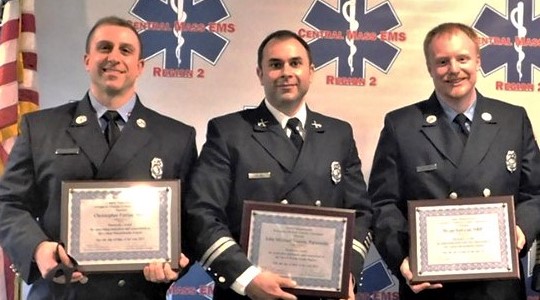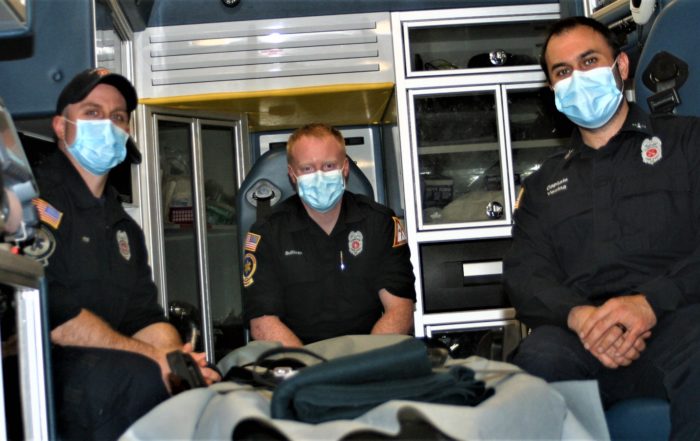LIGHTHOUSES
There are lighthouses all around us – seemingly ordinary people who bent the arc of our life; an elementary school teacher, a kind neighbor, a coach or a good friend.
The lighthouse is the tallest structure in the sea. In that flat and often turbulent world, this centuries-old architectural marvel stands tall and noble, focused on its particular mission: guiding the journey of the traveler. While technology has replaced much of the functions of the lighthouse, it still inspires us. Perhaps that is because the best attributes of the lighthouse are also the best elements of humanity — humility, steadiness, resilience and faithfulness.
There are thousands of lighthouses across the world, but the most powerful ones of all are the human ones. They are all around us, living quietly in our towns and communities but nevertheless bettering the world by helping those who have lost their way or find themselves navigating a storm. In the hectic pace of our busy lives, we often miss them because they seek neither reward nor recognition. But their impact is immeasurable. As time passes and we reflect upon our own life journeys, we can remember those seemingly ordinary people who bent the arc of our life; an elementary school teacher, a kind neighbor, a coach or a good friend. Life moves on, but our memories of them do not. Time teaches us just how important they really were.
The stories of these everyday people are the ones we want to share here at Town Square. Send us your nominations for Lighthouse of the Week to submit@centralmasstownsquare.com!

Successful Live Rescue
UXBRIDGE, Mass. – When Chris Fortier found himself behind the wheel of a fast-moving ambulance last fall, he was just three months away from finishing his paramedic education. His colleagues, Brian Sullivan and Captain Michael Vezina, were in the back vigorously working to keep a suicidal patient alive. At that moment, Fortier’s only job was delivering that patient to the Milford Regional Medical Center.
“It was critical,” Fortier recalled. “I knew I needed to get to the hospital, and I was completely unaware of what was going on in the back of the truck. I didn’t know what they were doing until I opened the back door at the hospital. Honestly, I don’t remember the drive to the hospital at all. I just knew I had to get there.”
Sullivan interjected, “I remember. He drove fast, but smooth. He got us there safely.”
But this was only the end of the ordeal. This rescue mission began about twenty minutes earlier when Vezina, a nine-year veteran of the Uxbridge Fire Department, received a call about an attempted suicide over the Uxbridge Police Dispatch radio. The response from the Uxbridge Police and Fire Departments was immediate.
“It was reported that a man was trying to hang himself from a tree deep in his backyard woods,” Vezina said.
Uxbridge Police Officers Kevin Sullivan and John Larrabee were the first responders at the scene. Bryan Sullivan said the officers were faced with a key decision before paramedics arrived. Sullivan spoke with Larrabee about the incident during a “stress debriefing,” which is an interview technique specifically designed to assist first responders with physical and psychological symptoms generally associated with the exposure to trauma.
Officer Larrabee told Sullivan that, with a drop of twenty feet, he was conflicted. Sullivan said he wasn’t sure if he should leave the man hanging in the air or to cut him down with such a large drop below. With no time to lose, Larrabee quickly decided to cut him down.
“That was absolutely the right decision to make,” said Sullivan, a three-year veteran of the Uxbridge Fire Department. “If he left him hanging in that tree, the severe damage he would have done to his neck from that rope would have totally closed his airway, eliminating any chance of survival.”
Fire Chief Tom Dion agrees that the actions of the two police officers played an important role early on into the rescue. “They took action immediately and made a difficult but necessary decision early on prior to our arrival which, without question, ensured that the patient’s survivability would be possible.”
As the paramedics exited the ambulance, looming in their way was a sizable retaining wall made up of large boulders. The wall supported the soil of a steep incline laterally, which was covered in tall grass. At the top of the hill, wedged between a tree and a rock formation was a man lying motionless on the dirt floor of the woods.
“When we rolled in, we saw him lying on the ground at the top of the hill,” said Fortier. “When we got there, we didn’t care about the terrain of the hill, our focus was on helping that patient.”
All three quickly climbed the retaining wall and then the hill. Sullivan and Fortier were first up with an airbag and a cardiac monitor. Vezina followed carrying a backboard and a suction unit to help clear any airway obstructions. When they reached their patient, they took over for the Uxbridge Police who made sure the scene was safe. Vezina said they conducted a quick assessment of the patient’s injuries. They checked to see if his airway was clear or if he was still breathing. Fortier said the man’s breathing was shallow due to structural damage of soft tissue in the person’s neck, causing it to swell and obstruct breathing.
“That type of breathing is not sustainable for too long,” Fortier said. “We had no time to be nervous. We just followed tasks we’ve been trained to do.”
After C-spine immobilization to avoid any significant spinal injuries or paralysis, ventilation to help keep oxygen flowing through the patient’s lungs and an intravenous (IV) tube in the patient’s arm, it was time to move.
The cavalry, consisting of Chief Dion and firefighter/EMTs Michael Deluca and Stephanie Benoit, had arrived to help the patient maintain breathing and transport them down the hill and into the ambulance.
“Going up the hill is much easier than coming down with the patient,” Vezina said. “There was a lot of tall grass and a weird trench from erosion that we had to look out for. We had to really watch out for this super steep decline towards the end.”
“We really have to trust each other when transporting like that,” Sullivan said.
“We especially had to hope no one slips,” Fortier said. “It was difficult, but the Chief helped by calling out to us while we went down. It was everyone working together.”
Adding to the difficulty, they had to make sure they continued ventilation. “During the course of transporting him down the hill, it made it difficult to bag [ventilate] him,” Sullivan said. “Just the progression of that injury made it more difficult.”
Once at the bottom, they placed the patient with the backboard on the stretcher and loaded them into the back of the ambulance. Sullivan and Vezina continued to treat the patient in the back of the ambulance as the doors were shut behind them. Fortier took the wheel, flashed the lights and siren and they were off.
While Fortier put the ambulance in drive toward the hospital, Sullivan and Vezina saw the patient’s swelling worsen and his jaw was completely clenched shut. His chances of survival were rapidly diminishing.
The patient also showed signs of tachycardia, or an elevated heart rate, and a decrease of what Vezina called his SPO2, which is a basic measurement of the amount of oxygen in the blood. The human body needs effective blood oxygenation to supply energy to muscles needed to function. Due to the patient’s rapidly declining condition in the back of the ambulance, Sullivan and Vezina were forced to make a quick decision. They realized the Life Flight Air Ambulance and the Trauma Center at UMass Memorial Medical Center in Worcester were too far away to treat the patient’s symptoms properly, and he was in desperate need of Rapid Sequence Intubation (RSI), an airway control technique that uses powerful sedatives and paralytic drugs to quickly gain control of the airway. And so, they changed their route and headed to Milford Regional Hospital instead.
In the meantime, changing the route to Milford did not address the issue of an elevated heart rate and the threat of hypoxia. Sullivan and Vezina deemed that airway management was their top priority and decided to perform an unorthodox procedure to assure the patient was going to arrive at the hospital still breathing. During the transport, Vezina performed a blind nasal intubation, or the insertion of a hollow tube to help reestablish the airway flow.
Vezina placed a 5- to 6-inch endotracheal tube through the patient’s nose, but it was too short. “I had to do it by feel,” he said. “There are no landmarks to follow, so to speak.” He switched to a 10-inch, tube which secured the airway until they were able to make it to the hospital.
Once the tube passed through and the airway was secured, a rush of oxygen entered the patient’s lungs. His heart rate and the SPO2 readings stabilized. “There was no more shallow breathing and his heart rate came down,” Vezina said. “At that point, we have done everything we could do. It was a sense of relief. It was probably the first time we could take a breath and relax.”
Thanks to the smooth ride from Fortier behind the wheel, Vezina was able to hold the breathing tube steady with his fingertips. Their quick actions and calm decision making saved the life of a man who did not want to live. The patient was healthy enough to be released from the hospital several weeks later.

From left to right: Chris Fortier, Mike Vezina and Bryan Sullivan. Courtesy photo.
As recognition for their heroic work, Vezina, Sullivan and Fortier were nominated by their peers and jointly awarded the Central Mass EMS Corp Paramedic of the Year Award in May.
“They were faced with a patient that was highly unlikely to survive, but their skilled actions and teamwork changed that,” said Tina Dixson, executive director of Central Mass EMS Corp. “They successfully performed some rarely used skills … They presented themselves with professional humility and appeared grateful for the recognition.”
Chief Dion commended everyone involved with the rescue. “Due the quick action and sharp decision making of the entire team involved, what would have most likely been a tragic outcome, was changed substantially,” he said. “I am extremely proud of this team and the job they did.”
Sullivan, Fortier, and Vezina all said they could not have made this successful rescue on their own. They credit the collaborative work of Chief Dion, Deluca and Benoit, along with Officers Kevin Sullivan and Larrabee, as being vital contributors to this successful rescue.
“This was a great outcome and it’s never the result of one person,” Fortier said, who did become an official Uxbridge paramedic following the rescue. “This was truly an example of teamwork.”


